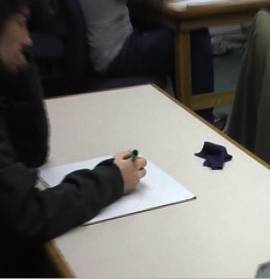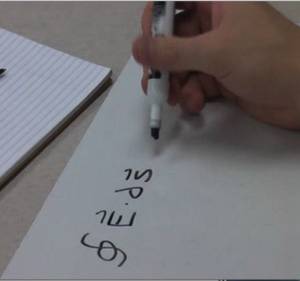You are here: start » whitepapers » narratives » fluxshort
Example of Introducing a Concept with a Small White Board Question Followed by a Kinesthetic Activity
Physics 422, Monday, November 10, 2008, Day 1
by Emily van Zee, Elizabeth Gire, and Corinne A. Manogue
This interpretative narrative is based upon a video of the class session and discussions with the instructor, Elizabeth Gire, and the director of the Physics Paradigms Program, Corinne Manogue. In writing the narrative, Emily van Zee drew upon her research in the tradition of ethnography of communication (Hymes, 1972; Philipsen & Coutu, 2004; van Zee & Minstrell, 1997a,b), a discipline that studies cultures through the language phenomena observed. This interpretative narrative presents an example of an instructor engaging students as novice participants in the culture of “thinking like a physicist.”
This narrative presents an example of the use of a small whiteboard question and a kinesthetic activity to introduce a concept in a junior-level physics course. The context is the concept of flux in a static vector field.
In entering the classroom, each student had picked up a small whiteboard, marker, and cloth to use as an eraser. The students expected that during class the instructor might ask them to write or draw answers to specific questions pertinent to the day’s topic. With some small whiteboard questions, the students merely hold up their whiteboards so the instructor can quickly view their responses and gauge the extent of everyone’s understanding. In this example, however, the instructor collected some of the whiteboards and used them as the focus for an introductory conversation about a topic. The students also anticipated that the instructor might engage them in an intriguing activity to help them envision a difficult concept. Sometimes the activities involved the students in moving about in interesting ways. In this example of such a kinesthetic activity, the instructor directed a few of the students in acting out a concept as she facilitated a class discussion about what they were doing.
This was the first day of Physics 422, Static Vector Fields, in which junior-level physics students considered the concept of flux, a concept which students sometimes find difficult to envision. The instructor first reviewed previous relevant coursework, next asked a small white board question to elicit the students’ initial knowledge about flux, and then engaged the students in discussing a kinesthetic activity that provided a visual representation of the concept.
Reviewing Previous Relevant Coursework [00:00:38.16]- [00:03:11.29]
The instructor, Liz Gire, opened class with an invitation to the students to review the main ideas that they had learned in a previous course on symmetries and idealizations in problem-solving. When a student mentioned Coulomb’s Law, vector fields, and Taylor series, she asked for elaboration, “I want to go back to the first thing you said, Coulomb’s Law as an example of a vector field. Can you say more about that?” Through this elicitation process, a student, rather than the instructor, articulated clearly a central idea for the day’s topic: “A vector field is a function that takes every point in space and gives it a value and a direction.”
The student also mentioned the potential, which is a scalar, but then seemed to falter. Liz stepped in to review the two types of fields, a scalar field, such as an electric potential, that has a value at every point in space but does not have a direction, and a vector field, such as an electrostatic field, that has a direction associated with the magnitude.
With a “What else?” Liz continued to invite participation in the review. Another student responded with a comment about learning how to change coordinate systems. She affirmed this by noting they had focused specifically on curvilinear coordinate systems to take advantage of the symmetry of some problems.
Speaking softly, another student offered that they had talked about the energy contained in an electric field. After re-voicing this contribution so that all could hear it, Liz commented that they also had discussed ways to describe various distributions of charges.
Opening a New Topic With a Small White Board Question [00:03:11.29] - [00:08:57.06]
After this brief review, Liz provided an overview of what was coming. Noting that the earlier course had been about electricity and magnetism, she stated that now they were going to enlarge their understanding by talking about magnetic fields, current densities, and potentials that are associated with magnetic fields.
Stating the question
Liz began the new material by posing a small whiteboard question:
L: And the first idea we're going to talk about, we're going to talk about the idea of FLUX On your small white boards, write something that you know about flux.
Picking up whiteboard responses to consider.
Liz moved around the room to see what the students were writing and/or drawing. As some were finishing, she began picking up a few of the whiteboards and placing them, back side to the class, on the ledge of the black board at the front of the room. By hiding what was written, she allowed the students still working to continue without distraction. By taking care with how she placed the whiteboards, she also could choose the order in which to focus attention as the class considered one board at a time. 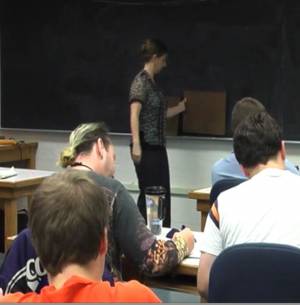
As Liz continued walking around picking up whiteboards that she wanted to discuss, she commended the students, “I am seeing lots of good things.” She also made a joke that prompted student laughter, a way of diffusing some of the tension that can occur when students are asked to display what they do - or do not – know. 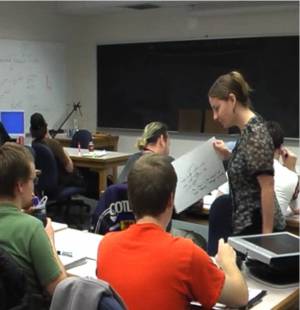
Considering the first whiteboard.
Liz began the discussion by holding up one of the whiteboards so all could see it. She read the inscription, “This one says 'The flux is the amount of field 'flowing' through an area.” After describing the drawing of a rectangular area with arrows pointing through it, she asked “What do you think about this?” 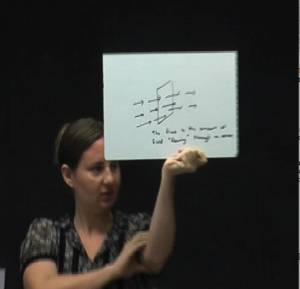
A student responded with a comment about a perpendicular component. Liz acknowledged this by repeating his words, “something about a perpendicular component.” The student continued with a statement about a cross product between a vector field and an area vector. Liz again repeated his statement without comment. Rather than correcting the student directly, Liz chose to initiate a conversation she had planned to have about the concept of ‘a piece of area.’
Using a physical representation of an abstract concept.
To help students visualize a ‘piece of area,’ she had brought to class a physical representation big enough for all to see.  Picking up a hula hoop, she held it high and asked a question:
Picking up a hula hoop, she held it high and asked a question:
L: So let's say here is my little piece of area. Which way does the area vector point?
In response to a student suggestion, she confirmed that the area vector would point out of the surface. Gesturing with her thumb, she illustrated the two possibilities while stating that it would point either “out” toward the students or “out” toward her, depending upon which way she chose. She was making here an explicit statement of a cultural practice, that physicists decide how to set up a problem by considering what makes sense in that particular problem setting.
Without referring back to a student’s earlier incorrect comment, Liz next addressed the issue the comment had raised:
L: So if I'm talking about a vector that is pointing through this area, do I want to take the cross product or the dot product?
Several students voiced ‘the dot product’ and Liz confirmed this, “All right, I want the dot product through the area.”
Putting down the hula hoop, she picked up the small white board again, held it high for all to see, asked, “Anything else you want to say about this one?” Although she waited before going on, no one chose to respond.
Connecting to students’ prior knowledge from other contexts.
Liz picked up another whiteboard from the ledge 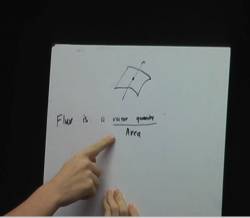 and asked, “What about this one?” and then described it:
and asked, “What about this one?” and then described it:
L: I've got a similar sort of picture, I've got a little square with an arrow pointing through and it says “Flux is a vector quantity” and this looks like divided by area. What do you think about that?
Then she turned back to the ledge and picked up the first whiteboard again. Holding both high for all to see, she acknowledged that these were appropriate responses given their prior knowledge about fluid flows and light.
L: Both of these are really productive ways of thinking about fluid flow and about light flowing through an area and when we talk about flux this is the type of thing that we're talking about.
This was a straight forward acknowledgement of conceptual meaning, based on student input, both verbal and visual, for contexts within which the concept of flux was familiar.
Articulating nuances of the concept in the new context.
Liz then stated new information in a mini-lecture that articulated similarities and differences between what the students knew from earlier contexts and what they would be learning about flux now for this context:
L: In E and M we talk about flux a little bit differently. In E and M we still talk about the amount of field pointing through an area, but we don't think about it as a flow. And this idea of amount of flow per unit area is not how we think about it in E and M.
She then picked up the hoop again to emphasize the importance of the size of the area:
L: In E and M it is the amount of field that is pointing through an area and the size of the area matters so the bigger my area for the same field in the same location, the more flux I have.
She reiterated the difference between an idea involving a division, finding a quantity for a unit area, and this new idea involving multiplication:
L: So in E and M we're not talking about the amount of field per unit area, we're talking about a multiplication between the field and the area.
By ending with a metacognitive checking question, “Does that make sense?” she signaled that this was an important but potentially confusing distinction between two closely related ideas and confirmed that one of these was applicable in this context.
Using a whiteboard response to present a mathematical representation.
Liz now turned back to the ledge and held up a third whiteboard on which a student had written a mathematical expression involving an integral of a dot product of a vector $\Vec B$ and a differential area, $d\Vec a$.
She articulated its meaning:
L: This is a mathematical representation of that idea: I have some field, and part of that field is on a surface, and part of that field is perpendicular to that surface, and I'm going to count up all the bits and pieces that are perpendicular to that surface. 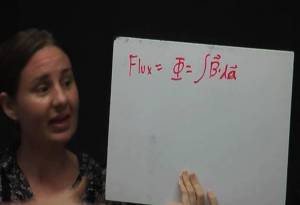 I'm going to take a dot product of my field and my area and I want to do this for every point that lies within my area. Make sense? Ok.
I'm going to take a dot product of my field and my area and I want to do this for every point that lies within my area. Make sense? Ok.
Although some of the students had been able to draw and write useful representations of the concept of flux based on their prior knowledge, Liz wanted to emphasize the distinction between the concept of flux as a flow through a unit area, appropriate for thinking of fluid flows, and the concept of flux for an electric or magnetic field integrated over a surface.
Engaging Students in an Activity and Discussion to Demonstrate an Abstract Concept
To illustrate the appropriate interpretation of flux in the context of electricity and magnetism, Liz handed out some rulers and meter sticks to students sitting near one another. She identified the rulers and meter sticks as vectors and the set of them as the vector field. The students held the rulers and meter sticks at different angles with respect to the plane of the hoop as she brought the hoop near.
First she held the hoop so that some of the rulers and meter sticks started in the plane of the hoop. 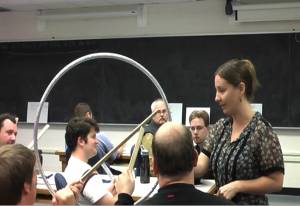
L: So I can think about flux as being the measurement of how much of your vector, how much of my vector is pointing through my little gate So here I have some non-zero flux because at the points that lie along the surface of my area there is some value of the field. ok?
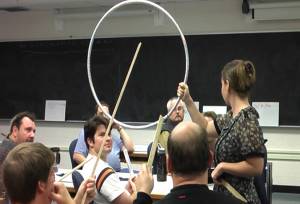 Next she moved the hoop where there were no rulers or meter sticks:
Next she moved the hoop where there were no rulers or meter sticks:
L: If I move my area over here, there's no flux, no vector field.
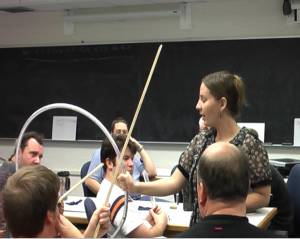 Then, however, she moved the hoop where a meter stick poked through the hoop but was held by a hand outside of the plane of the hoop.
Then, however, she moved the hoop where a meter stick poked through the hoop but was held by a hand outside of the plane of the hoop.
L: What if I put my hoop here. Is there flux or no?
When some students answered, “yes,” Liz asked, “How can you tell?” When a student responded, “There's a vector going through it,” Liz asked, “What is the field at a point that's lying in my area ?”
Then she articulated the idea she wanted them to grasp, that the vector started at a point outside the loop, “NOT in my area.” While acknowledging confusion, she reiterated what she wanted them to understand, that the base of the vector needed to be on the surface of the area.
L: So the representation of having fields represented by arrows is a little bit confusing here because the arrows take up space and we're talking about a function over space. So when you're calculating flux the thing that matters is what is the field at the point that's lying on the surface of my area and not when I draw the arrow does the tip of the arrow go through here. Making sense?
By using rulers and meter sticks to represent the arrows of vectors, she made a visual representation of the difficulty that can confuse students, the difference between the magnitude and direction of a vector at a point and its representation as an arrow in space.
